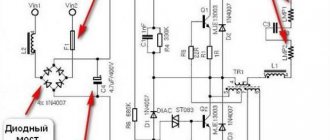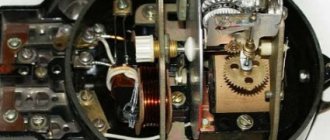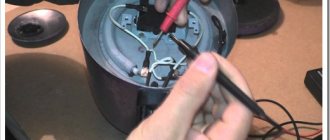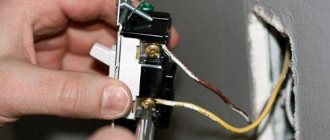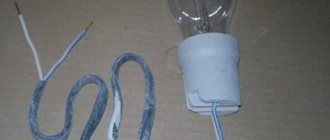When is a lamp dangerous to life and health?
Energy-saving compact fluorescent lamps contain mercury.
When it heats up and turns into a gaseous state, an electric current passes through it, which causes the device to glow. When mercury vapor is contained in the confined space of the lamp filament, it can in no way cause harm to humans or the environment. However, if the gas or particles of the metal itself become airborne, it can have negative health effects. Poisoning with the substance causes the following symptoms:
- general weakness;
- fast fatiguability;
- all signs of intoxication (vomiting, abdominal pain, nausea);
- damage to the central nervous system;
- damage to the liver, kidneys and other internal organs;
- fatal outcome at high concentrations of mercury and its compounds in the air.
Consequences of improper disposal of energy-saving light bulbs
Heavy metals, at the base of fluorescent lamps, are highly toxic volatile substances. Hazardous elements penetrate the soil and water bodies, and then into plants and animal tissues. Contaminated agricultural products end up on our tables.
The metal is not excreted by the body, but accumulates for many years, causing systematic poisoning. It leads to:
- Weakening of the immune system (chronic diseases, regular relapses of acute respiratory viral infections, allergies).
- The gastrointestinal tract suffers (nausea, diarrhea, lack of appetite, exacerbation of chronic peptic ulcer disease, internal bleeding).
- Disruption of the central nervous system (chronic weakness, fatigue, migraines, tremors, outbursts of aggression, apathy, sclerosis).
- During pregnancy, heavy metal enters the fetus through the placenta, which can lead to developmental disorders or stillbirth.
The amount of mercury in lamps
You can determine how much mercury is in an energy-saving lamp by studying its composition on the packaging. Russian and Chinese manufacturers produce lighting elements that contain from 3 to 5 mg of liquid metal. Lamps of European brands use amalgam - alloys that contain mercury. In its solid state, the substance is safe, but when heated it turns into vapor; if the lamp explodes during operation, its harmful compounds will be released into the air.
To understand how dangerous a broken energy-saving lamp is, you need to know the maximum permissible concentration of a pollutant in the air.
According to the hygienic standards GN 2.1.6.1338-03 “MPC of pollutants in the atmospheric air of populated areas”, section II, the maximum permissible concentration of mercury and its compounds is considered not dangerous to life, health of a person and his future offspring if it is 0.0003 mg/m³.
Let's consider how much this value can exceed the norm using a simple example. Let’s assume that a light bulb containing 5 mg of mercury broke in a room with an area of 20 m² and a ceiling height of 3 m. The total area of the room in which the contamination occurred is 60 m³. After calculation, it is clear that the concentration of the harmful substance is 0.083 mg/m³, which is 276 times more than the permissible limit.
It is important to know! Mercury and its vapors may not initially show any negative effects on the body. This is a substance that has the ability to accumulate in tissues and organs. When enough of it accumulates, signs of poisoning begin to appear.
Types of lamps containing mercury
Phosphor is a light transparent coating on the inside of a glass bulb for a light-emitting reaction, found in all fluorescent lamps and fluorescent emitters.
If a mercury-containing lamp breaks in a room, carefully collect the fragments with a damp cloth and ventilate the room. However, do not use a vacuum cleaner.
Types of gas-charging lamps filled with liquid metal include:
- luminescent;
- quartz;
- bactericidal.
They can be of different shapes, give a different spectrum of glow (cold or warm), but they all contain mercury in the core.
LED
LED light sources are the least dangerous for humans and nature. They do not contain heavy metals. The cartridge, which includes a stabilizer, electronic elements of the base can be reused or recycled.
The hazardous waste classification does not include LED lamps as potential sources of pollution. However, in the manufacture of cheap LED lamps, lead is used for the metal parts of the lamp. Therefore, it is recommended to dispose of LEDs in the same way as fluorescent lamps.
View this post on Instagram
Posted by Wholesale Retail Store (@smart_electro05) Jul 11, 2019 at 5:07 am PDT
Incandescent and halogen
Incandescent lamps, while consuming high energy, have low luminous efficiency and lifespan compared to more modern light sources. From an environmental point of view, such a lamp does not pose any danger to the environment or human health.
Radiation occurs due to the heating and glow of a tungsten arc in an inert gas. If the bulb of an incandescent lamp is damaged, no hazardous substances are released. Therefore, ordinary emitters do not require special disposal.
The tungsten arc contains more modern lighting sources - halogen lamps. The difference from an incandescent lamp is that the bulb cavity contains a mixture of halogen gases, which increases light output and service life while reducing energy consumption.
Since halogen lamps do not contain substances hazardous to the environment, legislation does not establish strict requirements for their disposal. For halogen products, lamps can be recycled and reused.
View this post on Instagram
Publication from Studio “Yana Loft” (@yana.loft) Aug 20, 2021 at 11:36 PDT
Mechanical removal of harmful substances
If energy-saving lamps contain mercury, damage to their integrity can be hazardous to the environment and people. If such a problem arises, strict regulations must be followed to clean the premises from harmful substances and dispose of materials.
To avoid vapor poisoning, follow these steps:
- Remove all people and living beings from the room.
- Close the door tightly to prevent vapors from spreading into other rooms.
- Open the windows, ventilation for 24 hours will help completely remove mercury vapor.
- After the room has been ventilated for 2 hours, you can begin to dispose of lamp fragments and mercury particles. To do this, wear clothes with all parts of the body covered, rubber shoes and rubber gloves, protect the respiratory tract with a gauze bandage moistened with water or soda solution.
- Prepare a container in which you will put the remains of the lamp. This should be a jar filled with water or a solution of potassium permanganate (2%).
- Enter the room and close the door tightly behind you. You can collect light bulb particles using the following items:
- tape;
- wet sponge;
- syringes;
- wet cloth and cardboard.
You need to assemble absolutely all the elements, including the base. Place them in a jar with a solution of potassium permanganate, and send all the items used for cleaning there. Close the jar tightly with a lid and take it to a cool, dark room.
The lamp broke. What to do?
The question arises, what to do if the light bulb does break, and mercury vapor is so dangerous.
First: don't panic. If there are several people in the apartment, urgently evacuate the extra people; To eliminate the consequences, one, maximum two people should remain to avoid mass poisoning. Close the doors tightly to prevent harmful impurities from leaking into other rooms, open all windows to create a draft to reduce the effect of vapors on the respiratory system. Collect the fragments in a bag and, as far as possible, seal it tightly without touching it with your bare hands.
It is better to work with rubber gloves. Wipe the dirty areas with a damp cloth and place them in the bag as well. Carpets should be taken outside and beaten, placing the inside side down, but not on the ground; To prevent soil contamination, place a damp sheet or oilcloth.
Demercurization (the process necessary to neutralize mercury) must be carried out. There are special services for this. If it is not possible to invite specialists, the room where the mercury lamp has broken will be properly cleaned using the following compounds:
- solution of potassium permanganate (2 g per 1 liter of water). Apply the resulting mixture to the contaminated area and wash it off with soapy water after 6–7 hours;
- baking soda solution (400 g of soda per 10 liters of water and a little soap suds). Chlorine-based bleaches can also be used;
- for minor stains, you can take 100 ml of iodine per liter of water and treat the surface with this composition.
Procedure for cleaning up fragments containing mercury vapor
Chemical treatment
In order for mercury residues to cease being harmful to health, all surfaces in the room must be treated with special compounds. The goal is for the mercury to react with chemical components to form mercury salts that can be easily washed off. You can use the following solutions:
- potassium permanganate and water: add 2 g of potassium permanganate to 1 liter of water;
- iodine solution: for 1 liter of water you need to take 100 ml of iodine;
- soap-soda: for 10 liters of water take 400 g of baking soda and 400 g of soap solution, mix everything thoroughly;
- chlorine-containing: regular “Belizna”, “Domestos” and other chlorine-containing detergents are suitable.
All surfaces need to be treated with these solutions every 4-6 hours for 3 days. Particular attention should be paid to hard-to-reach places, such as niches under furniture, cracks in the floor, and far corners.
The more thoroughly you carry out demercurization (removal of mercury residues), the greater the chance of not suffering from its leakage.
It is strictly prohibited when cleaning:
- turn on the air conditioner, as mercury vapor can settle on its mechanism, and the device will become a distributor of harmful compounds;
- use a vacuum cleaner, it can also cause subsequent air pollution with chemicals;
- use a broom or broom to collect glass, this will raise dust and all harmful components will move up from the floor;
- pick up lamp particles and cleaning items with bare hands;
- throw parts of the lamp into the garbage chute or trash cans;
- Pour water with remaining lamps down the drain.
What should you not do?
There are a number of prohibitions that also need to be taken into account. So, you can't do the following:
- collect the light bulb particles with a vacuum cleaner, otherwise the mercury will end up inside and settle there;
- turn on the air conditioner, as mercury vapor will settle inside it;
- use a broom or broom, as too strong movements will cause particles to scatter throughout the room;
- throw glass particles or a jar of waste into the garbage chute or take it to the trash;
- pour liquid from a jar containing the remains of a broken lamp down the drain.
Used whole light bulbs should not be thrown into the trash. They are handed over to collection points. Information on where to donate energy-saving lamps can sometimes be found in stores specializing in the sale of such devices. Sometimes used lamps can be handed over to points in these stores. If this is not possible, you can find out where to donate energy-saving light bulbs and where to dispose of leftovers if the lamp breaks by calling emergency rescue organizations.
Special services for demercurization
Specialists from companies involved in demercurization can remove harmful substances indoors. They not only perform mechanical and chemical cleaning of rooms, but also measure the concentration of mercury in the air. Using them, you can find out whether upholstered furniture, carpeting and other items that are difficult to mechanically and chemically treat are suitable for use.
The cost of services from such companies is rather high, but they guarantee the complete removal of volatile and solid harmful substances from the premises.
You can find phone numbers for companies in a city directory or on the Internet. However, please note that such services are only available in large cities.
Dangers of mercury entering the human body
Mercury belongs to the group of toxic substances. At high concentrations, it can cause the following phenomena in the body:
- headache;
- nausea;
- dry throat;
- diarrhea;
- abdominal cramps;
- damage to the liver, kidneys;
- disruption of the central nervous system, etc.
Exposure to mercury vapor is most dangerous for pregnant women and children.
If one light bulb in a room is broken, the harmful effects may not be immediately noticed, since the concentration of the toxic substance in one device is low. But, according to experts, mercury tends to accumulate in the human body, gradually poisoning it. The effects of the poison can be felt after five, ten or more years. Moreover, scientists claim that the consequences of exposure can be varied and quite serious. These include vision problems, dementia, various diseases of the nervous system, etc.
What to do with waste after cleaning
When you have successfully carried out demercurization, a completely logical question arises about waste disposal. Whole energy-saving lamps are collected in special eco-containers installed in big cities. Large companies enter into contracts with companies that take away lots of used lighting fixtures for recycling.
At special plants, of which there are now more than 50 in Russia, demercurization of raw materials is carried out using hydrometallurgical or thermal technology. After this, the neutralized glass, metal and other particles are reused.
But disposing of a jar of water and lamp residue is not so easy. Waste of the first hazard category can only be handed over to the unified duty and dispatch service under the Ministry of Emergency Situations. If you do not want to look for one, you can contact a demercurization company.
It is worth noting that employees of public and private companies involved in recycling energy-saving lamps willingly accept waste and even thank conscientious citizens for not throwing the remains into a landfill.
How to prevent mercury leakage
No one is immune from chips and cracks in energy-saving lighting fixtures. However, every user of compact fluorescent lamps should know that they should not be thrown away with other waste. Don’t be lazy to find a special collection point for such lamps, this will help save the health of millions of people.
If you are afraid that the lamp will break indoors, you can use analogues that do not contain mercury. These are gas-discharge and LED lighting devices. However, their cost will be several times higher than the cost of CFLs.
You can also choose new generation fluorescent lamps that do not contain liquid mercury. They are produced by European manufacturers; information about the absence of harmful substances is indicated on the packaging.
Is there mercury in energy saving lamps?
Energy-saving lamps are much more profitable than conventional incandescent lamps; in addition, the Russian Federation has adopted a law on the gradual removal of the latter from use. The most popular “housekeeper” option is the compact fluorescent lamp (CFL), it has a long service life and consumes much less energy with better color rendition. However, such lighting devices have a serious drawback - a health hazard under certain conditions.
When is a lamp dangerous to life and health?
Energy-saving compact fluorescent lamps contain mercury. When it heats up and turns into a gaseous state, an electric current passes through it, which causes the device to glow. When mercury vapor is contained in the confined space of the lamp filament, it can in no way cause harm to humans or the environment. However, if the gas or particles of the metal itself become airborne, it can have negative health effects.
Poisoning with the substance causes the following symptoms:
- general weakness;
- fast fatiguability;
- all signs of intoxication (vomiting, abdominal pain, nausea);
- damage to the central nervous system;
- damage to the liver, kidneys and other internal organs;
- fatal outcome at high concentrations of mercury and its compounds in the air.
The amount of mercury in lamps
You can determine how much mercury is in an energy-saving lamp by studying its composition on the packaging. Russian and Chinese manufacturers produce lighting elements that contain from 3 to 5 mg of liquid metal. Lamps of European brands use amalgam - alloys that contain mercury. In its solid state, the substance is safe, but when heated it turns into vapor; if the lamp explodes during operation, its harmful compounds will be released into the air.
To understand how dangerous a broken energy-saving lamp is, you need to know the maximum permissible concentration of a pollutant in the air.
According to the hygienic standards GN 2.1.6.1338-03 “MPC of pollutants in the atmospheric air of populated areas”, section II, the maximum permissible concentration of mercury and its compounds is considered not dangerous to life, health of a person and his future offspring if it is 0.0003 mg/m³.
Let's consider how much this value can exceed the norm using a simple example. Let’s assume that a light bulb containing 5 mg of mercury broke in a room with an area of 20 m² and a ceiling height of 3 m. The total area of the room in which the contamination occurred is 60 m³. After calculation, it is clear that the concentration of the harmful substance is 0.083 mg/m³, which is 276 times more than the permissible limit.
It is important to know! Mercury and its vapors may not initially show any negative effects on the body. This is a substance that has the ability to accumulate in tissues and organs. When enough of it accumulates, signs of poisoning begin to appear.
Mechanical removal of harmful substances
If energy-saving lamps contain mercury, damage to their integrity can be hazardous to the environment and people. If such a problem arises, strict regulations must be followed to clean the premises from harmful substances and dispose of materials.
To avoid vapor poisoning, follow these steps:
- Remove all people and living beings from the room.
- Close the door tightly to prevent vapors from spreading into other rooms.
- Open the windows, ventilation for 24 hours will help completely remove mercury vapor.
- After the room has been ventilated for 2 hours, you can begin to dispose of lamp fragments and mercury particles. To do this, wear clothes with all parts of the body covered, rubber shoes and rubber gloves, protect the respiratory tract with a gauze bandage moistened with water or soda solution.
- Prepare a container in which you will put the remains of the lamp. This should be a jar filled with water or a solution of potassium permanganate (2%).
- Enter the room and close the door tightly behind you. You can collect light bulb particles using the following items:
- tape;
- wet sponge;
- syringes;
- wet cloth and cardboard.
You need to assemble absolutely all the elements, including the base. Place them in a jar with a solution of potassium permanganate, and send all the items used for cleaning there. Close the jar tightly with a lid and take it to a cool, dark room.
Chemical treatment
In order for mercury residues to cease being harmful to health, all surfaces in the room must be treated with special compounds. The goal is for the mercury to react with chemical components to form mercury salts that can be easily washed off. You can use the following solutions:
- potassium permanganate and water: add 2 g of potassium permanganate to 1 liter of water;
- iodine solution: for 1 liter of water you need to take 100 ml of iodine;
- soap-soda: for 10 liters of water take 400 g of baking soda and 400 g of soap solution, mix everything thoroughly;
- chlorine-containing: regular “Belizna”, “Domestos” and other chlorine-containing detergents are suitable.
All surfaces need to be treated with these solutions every 4-6 hours for 3 days. Particular attention should be paid to hard-to-reach places, such as niches under furniture, cracks in the floor, and far corners.
The more thoroughly you carry out demercurization (removal of mercury residues), the greater the chance of not suffering from its leakage.
It is strictly prohibited when cleaning:
- turn on the air conditioner, as mercury vapor can settle on its mechanism, and the device will become a distributor of harmful compounds;
- use a vacuum cleaner, it can also cause subsequent air pollution with chemicals;
- use a broom or broom to collect glass, this will raise dust and all harmful components will move up from the floor;
- pick up lamp particles and cleaning items with bare hands;
- throw parts of the lamp into the garbage chute or trash cans;
- Pour water with remaining lamps down the drain.

